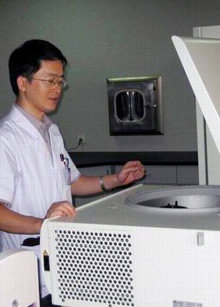The Technique and Clinical Application of Anatomical Retroperitoneoscopic Adrenalectomy
Lang Bin (Fourth Author)
2008 — 2009
On Behalf of Tongji Medical College of HUST
Hubei Provincial S&T Progress Award (First Prize), Ministry of Education S&T Progress Award (Second Prize), Chinese Medical Technological Award (Third Prize)

Dr Lang Bin
Associate Professor from School of Health Science
Laparoscopic adrenalectomy has become the preferred surgical therapy for adrenal tumors. However, the operation was in the past difficult and dangerous for beginners, leading to the possibility of lethal trauma to vessels and organs adjacent to the adrenal glands, due to the anatomical complexity of the adrenal gland and its location under the diaphragm and in close association with important organs and vessels such as liver, spleen, pancreas and vena cava.
To increase the safety of the laparoscopic adrenalectomy and make it easier for beginners, Dr Lang and other scholars have emphasised the study of the technique of retroperitoneal laparoscopic adrenalectomy. Through conducting anatomical research on cadavers and clinical studies of retroperitoneal laparoscopic operations, they explored three latent interfacial spaces around the adrenal gland and the kidney, called "3 relatively bloodless dissection planes". The first dissection plane is between the perirenal fat and the anterior renal fascia located at the superomedial side of the upper kidney pole. The second dissection plane is between the perirenal fat and the posterior renal fascia located on the lateral side of the upper kidney pole. The third plane progresses immediately adjacent to the parenchymal surface of the upper kidney pole. Thus the technique of anatomical retroperitoneal adrenalectomy (ARA) has been developed. The technique successfully solves the difficulty of exposing the adrenal gland and manipulation of the adrenal vessel, making the operation easier for beginners and shortening the operating time.
They have performed ARA on 1000 patients with adrenal diseases with satisfactory results, and the related research achievements have been published in journals such as the Journal of Urology, Urology, and Journal of Endourology. In addition, their paper on the ARA technique has earned several awards.



